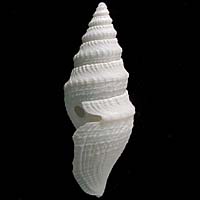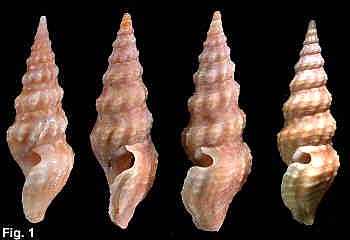|
< Previous family introduction |
|
|||||
 |
Family Turridae Turrids
|
|||||
|
The turrids are the largest family of marine gastropods, numbering more than 4,000 described species. In a recent paper, Bouchet et. al. (2004) said "turrids sing a hymn to specialisation, rarity and evolutionary innovation". They reported that 20 years of sampling off New Caledonia from the intertidal to 3,700 m had turned up 1,726 turrid species, as many as 30% of these species being represented by single specimens. A similar situation no doubt applies to the Australian and New South Wales fauna, with many species being rarely obtained and a high proportion un-named. Turrids shells show a diversity of shell shapes; some look like cones, others resemble mitrids, fasciolarids or buccinids. The one feature they have in common is a sinus - an indentation or slit at the upper end of the outer lip, which accommodates the exhalent canal. The sinus sometimes is only a weak depression, sometimes a deep slit, but most commonly a deep, rounded V shaped indentation. Turrids are carnivorous, probably all being predatory; polychaete worms are the major prey of the species of which the diet has been studied. Some have a radula and associated poison gland similar to the harpoon-like structure of the cone shells, while others have lost the radula and poison gland.. The family is represented in NSW by about 150 named species, only a few of which are common, and many of which are quite rare. A few small species occur intertidally under rocks on rocky shores, some occupy the shallow subtidal, down to about 20 metres and are occasionally washed up on beaches, but most occur in deeper water. About a dozen species exceed 20 mm in size, but the majority are quite small, many being under 5 mm in length. The classification of the Turridae is in a flux. A number of families and/or sub-families have been used, but there is not general agreement upon use of these names by specialists. Classification at the generic level is still fluid, and the limited specimens available often make decisions on species boundaries difficult. Our knowledge of the NSW fauna is the result of Hedley's monograph of the Australian species (1922), and Laseron revision of the NSW fauna in 1954, in which he dealt with 142 species. The monographs of Powell (1964, 1967, 1969) also refined NSW turrid systematics. Identification Notes The primary identification feature of turrids is the sinus, the indentation at the top of the outer lip. Its shape and position are important for classification. The sinus may be narrow and deep, broad and shallow, or a mere indentation as in members of the subfamily Mangelliinae. The apex of the sinus may be on the periphery of the last whorl, at the suture, or on the shoulder slope between suture and periphery. Development of the sinus proceeds as the shell matures, being only a shallow indentation in juvenile shells (see Fig. 1, showing sinus development with maturity in Vexitomina coxi). Some species have a callous nodule at the top of the inner lip of the aperture, opposite the sinus, which also increases in size with maturity.
Family Reference Hedley, Charles. 1922. A revision of the Australian Turridae. Records of the Australian Museum 13(6):213-359 Laseron, C.F. 1954. The New South Wales Turridae. Royal Zoological Society NSW. Zool. Handbook 56 pp. Powell, A.W.B. 1964. The family Turridae in the Indo-Pacific. Part 1. The subfamily Turrinae. Indo-Pacific Mollusca 1(5):227-345 Powell, A.W.B. 1967. The family Turridae in the Indo-Pacific. Part 1a. The subfamily Turrinae concluded. Indo-Pacific Mollusca 1(7):409-431 Powell, A.W.B. 1969. The family Turridae in the Indo-Pacific. Part 2. The subfamily Turriculinae. Indo-Pacific Mollusca 2(10):207-415 Wells, F.E. 1990. Revision of the Recent Australian Turridae referred to the genera Splendrillia and Austrodrillia. Journal of the Malacological Society of Australia 11: 73-117. Wells, F.E. 1991. A revision of the Recent Australian species of the turrid genera Clavus, Plagiostropha and Tylotiella (Mollusca: Gastropoda). Journal of the Malacological Society of Australia12: 1-33 Wells, F.E. 1991. A new species of Splendrillia, with comments on two other species in the genus. Journal of the Malacological Society of Australia 12: 63-67. Wells, F.E. 1993. New records of Splendrillia (Gastropoda: Turridae) from northwestern Australia, with the description of a new species. Journal of the Malacological Society of Australia 14: 113-117. Wells, F.E. 1994. A revision of the Recent Australian species of the turrid genera Inquisitor and Ptychobela. Molluscan Research 14: 71-103. Coverage Of the 150 or so NSW species only those which reach over 15 mm in length are described here. For information on the remaining species, see Laseron's treatment mentioned above.
|
